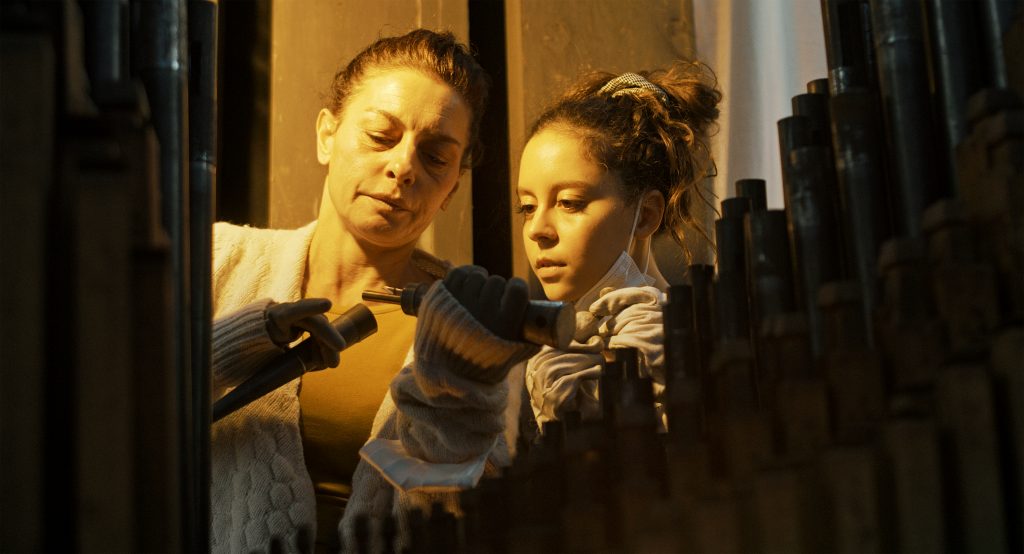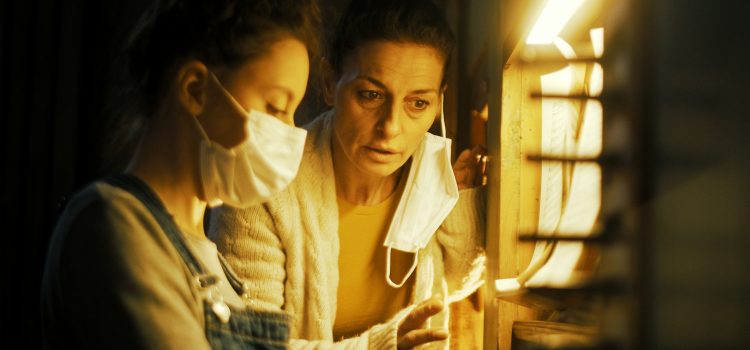By Alex McPherson
Fueled by isolation, passion, obsession, and music booming with magisterial grandeur, director Gabriele Fabbro’s “The Grand Bolero” demands the biggest screen possible.
This genre-bending tale unfolds in Northern Italy during the early days of the COVID pandemic, and it primarily takes place in a single location — a massive church dating back to 1700. Residing within are a jaded pipe-organ restorer named Roxanne (Lidia Vitale) and Paolo (Marcello Mariani), who maintains the church, continually ringing “the death bell” as pandemic casualties increase. After Roxanne’s assistant dies, Paolo insists that Roxanne take on a 20-year-old, mute helper named Lucia (Ludovica Mancini) to nurse the aging instruments back to life in exchange for giving Lucia food, music lessons, and a place to sleep. Roxanne treats Lucia like a subhuman, strictly enforcing rules and waking her up each morning by blasting the organs with all her might. Still, Lucia is a bubbly, persistent soul, and she’s quite the musician herself, catching Roxanne off-guard and building a possibly romantic connection with her. As Roxanne’s attachment grows, “The Grand Bolero” evolves into something altogether more sinister — for each party has their secrets, bubbling to the surface in sometimes explosive fashion.
Although Fabbro’s film becomes unwieldy in its last act, “The Grand Bolero” captures a rich sense of place with intriguing characters brought alive by excellent acting and one of the best soundtracks of the year.
Indeed, “The Grand Bolero” thrives on mood-setting. We hear wind blowing through groaning walls, the tactile creak of floorboards baked in history, and boisterous organs creating fleeting moments of harmony and elation craved by Roxanne in particular, all while Fabbro skillfully guides us through the spacious yet claustrophobic structure. COVID is rendered more as a backdrop to the proceedings, but in the sequences where the characters leave the church, cinematographer Jessica La Malfa’s camera presents their environment as downright post-apocalyptic, with grey skies, thick fog, and ambulance sirens quietly singing in the background.
The score — by Sean Goldman, Martino Lurani Cernuschi, and Paolo Sanvito — is adapted from works by classical composers, including Ravel, Wagner, and Tchaikovsky, among many others, and is a splendid accompaniment to the onscreen drama, channeling the central duo’s burgeoning love for one another, as well as lending Shakespearean weight to the craziness in the latter half. This music is its own character in the film, capitalizing on the animalistic impulses of the characters as if, in some strange way, judging them.
In terms of characterization, “The Grand Bolero” doesn’t shine quite as brightly, but there’s some welcome complexity nevertheless. Roxanne remains a mysterious presence to the end, possessing a misanthropic view of humanity that lends itself both to moments of dry wit and immoral decisions. Vitale, a legendary Italian star, expresses Roxanne’s sassy demeanor and inner demons with a weathered, mysterious performance in which we’re never really sure what Roxanne will do to achieve her goals. Mancini, given less material to work with, also gives an impactful turn as Lucia, an energetic, upbeat young woman who’s somehow been able to survive while stripped of resources and the ability to effectively communicate with those around her. We don’t get much information about either characters’ backstories — ultimately to the film’s detriment — but “The Grand Bolero” renders their relationship satisfying to watch develop, always buoyed by their shared adoration of the pipe organs they look after.
It’s therefore disappointing that the slow-building, contemplative approach of the first half devolves into chaos that’s too melodramatic and self-serious for its own good. Without having enough grounding for Roxanne’s character especially, life-altering decisions come across as clumsy and overly exaggerated. No spoilers here, but the film’s detour into thriller territory is difficult to take as seriously as Fabbro and co-writer Ydalie Turk likely intended.
Gripes aside, however, “The Grand Bolero” is a technically impressive, thoughtfully put-together production. Few films this year have used music to such expressive heights, and there’s definitely merit in a narrative that doesn’t use COVID as a means to talk down to audiences. While the emotional core isn’t as strong as it could have been, there’s much to appreciate within this sensual, sensorial story for our times.

“The Grand Bolero” is a 2021 Italian film with English subtitles directed by Gabriele Fabbro and starring Lidia Vitale, Ludovica Mancini and Marcello Mariani. It is not rated and runs 1 hour, 30 minutes. It is available virtually at the St. Louis International Film Festival through Nov. 21. Alex’s Grade: B+
Alex McPherson is an unabashed pop culture nerd and a member of the St. Louis Film Critics Association.

